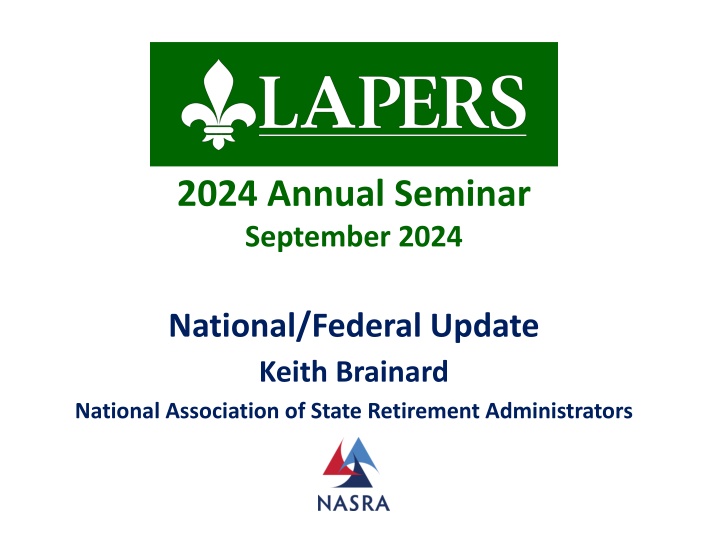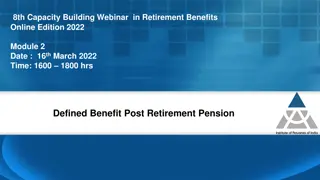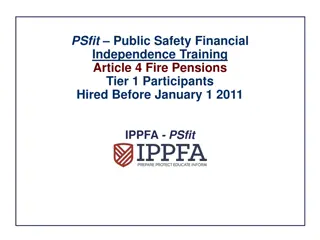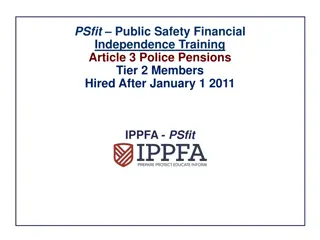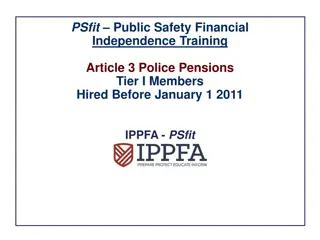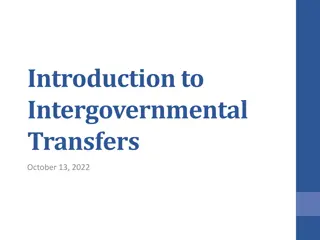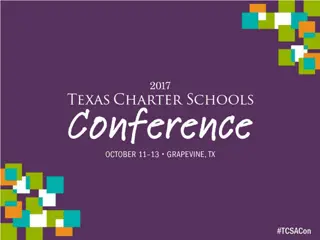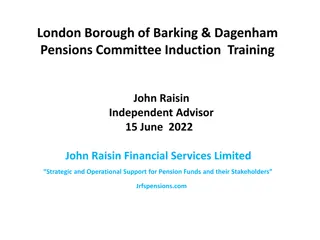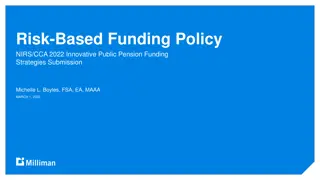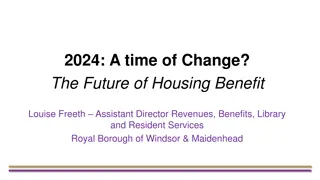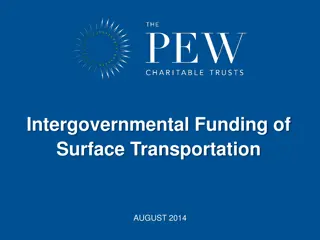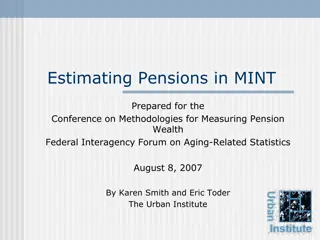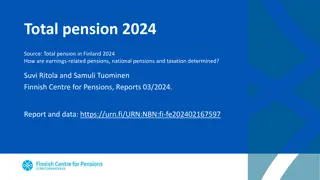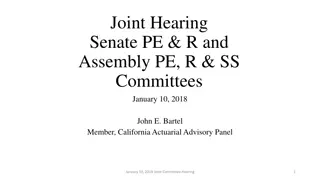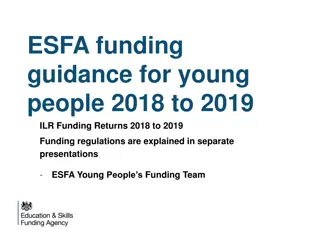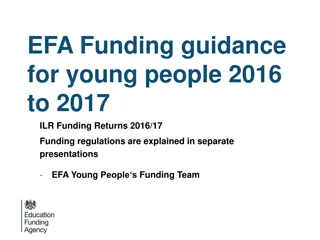Insights into Public Pensions and Funding Levels
landscape of public pensions in the U.S. and Louisiana, with details on assets, participants, retirees, contributions, and funding levels. Learn about the National Association of State Retirement Administrators' annual seminar, federal updates, and aggregate pension fund assets. Discover testimonials from state budget officers and predictions for pension funded ratios. Delve into the history of aggregate public pension funding levels and the factors influencing them.
Download Presentation

Please find below an Image/Link to download the presentation.
The content on the website is provided AS IS for your information and personal use only. It may not be sold, licensed, or shared on other websites without obtaining consent from the author.If you encounter any issues during the download, it is possible that the publisher has removed the file from their server.
You are allowed to download the files provided on this website for personal or commercial use, subject to the condition that they are used lawfully. All files are the property of their respective owners.
The content on the website is provided AS IS for your information and personal use only. It may not be sold, licensed, or shared on other websites without obtaining consent from the author.
E N D
Presentation Transcript
2024 Annual Seminar September 2024 National/Federal Update Keith Brainard National Association of State Retirement Administrators
Public pensions in the U.S. ~$6.0 trillion in assets (3/31/24) 14.9 million active (working) participants 9.4 percent of the nation s workforce 12.0 million retirees and their survivors receive $320+ billion annually in benefits Annual contributions = $283 billion $221 billion from employers $62 billion from employees Of 4,600+ public retirement systems, the largest 75 account for 80+ percent of assets and members Aggregate funding level = ~76% US Census Bureau, Public Fund Survey
Public pensions in Louisiana ~$65 billion in assets ~196,000 active (working) participants ~191,000 retirees and their survivors receive $5.3 billion annually in benefits More than 11 percent of the state s residents either participates in or receives a regular benefit from a public retirement system in the state. Annual contributions = $3.9 billion $3.1 billion from employers $850 million from employees Of 29 public retirement systems, TRSLA and LASERS account for more than 60%, and the largest 5, including Parochial ERS, Muni Police and Schools ERS account for 80+% of assets and members Aggregate funding level = ~75% US Census Bureau, Public Fund Survey
Testimonials National Association of State Budget Officers As states begin fiscal 2025, overall fiscal conditions remain strong as states invest in priorities, experience stable revenue outlooks, and maintain rainy day funds at or near all-time highs. June 2024 S&P Global We expect U.S. pension funded ratios will continue their upward trajectory in fiscal years 2024 and 2025 due to steadily positive market returns. July 2024
Aggregate Public Pension Fund Assets Are the Highest Ever Federal Reserve, compiled by NASRA
History of Aggregate Public Pension Funding Level FY 01 to FY 23 Phase-in of 2000-02 market losses Reforms: lower benefits; more risk-sharing; higher contributions; lower investment return assumptions Phase-in of 2008-09 market losses Equity growth and surging contributions
Distribution of Public Pension Funding Levels FY 23 LA Parochial LASERS TRSLA
Change in Funding Ratios of Selected Louisiana Plans Public Plan Data, Public Fund Survey
Median Annual Change in Aggregate Actuarial Assets and Liabilities
Median Annualized Public Pension Fund Investment Returns for Periods Ended 6/30/24
Public Fund Returns by Size: Smaller Funds Outperformed Larger Funds FiscalYear returns period ending June 30, 2024 14.0 12.9 13.1 25thPercentile 12.5 11.5 12.0 10.8 12.0 10.7 Median 11.7 10.9 11.1 75thPercentile 10.0 10.2 10.3 10.2 10.1 Percent 9.7 Return 9.2 8.9 8.0 8.5 6.0 4.0 2.0 0.0 PF $100M- $1B Total PF PF > $25B PF > $10B PF > $1B PF < $100M 25th Median 75th Smaller plans outperformed larger plans for the fiscal year as a result of lower real estate and alternatives allocations. Number of members in each group: Total PF 329; PF > $25B 25; PF > $10B 54; PF > $1B 126; PF $100M - $1B 125, PF < $100M 78 5 NASRA 2023 Annual Conference Knowledge. Experience.Integrity.
Median Contribution Rates Employee and Employer Social Security-Eligible and -Ineligible Social Security-Eligible Social Security-Ineligible Contribution rates reflected here are those for general employees and teachers and predominantly exclude rates for public safety personnel.
Distribution of Employer Contribution Rates Social Security Eligible and Ineligible, FY 23 Social Security-Ineligible Social Security-Eligible Contribution rates reflected here are those for general employees and teachers and predominantly exclude rates for public safety personnel.
ARC/ADC Experience, FY 01-FY 23 111 Plans
ARC/ADC Experience, FY 23 111 Plans
Comparison of FY 23 and FY 13 ARC/ADC Effort
ARC/ADC Experience, FY 01-FY 23 New Jersey TRS
Median Annual Change in Actives and Annuitants
Median Annual Change in Payrolls FY 02 to FY 23
Change in Louisiana State Population, 1950 to 2023 Macrotrends
Change in Number of Active Members per Annuitant for Selected Louisiana Plans Public Plan Data, Public Fund Survey
Actuarial Assumptions
Average Public Pension Plan Inflation Assumption vs. 20-Year Breakeven Rate The breakeven rate is a measure of expected inflation derived from 20-Year Treasury Constant Maturity Securities and 20-Year Treasury Inflation-Indexed Constant Maturity Securities. The latest value implies what market participants expect inflation to be in the next 20 years, on average.
Change to Median and Average Nominal Investment Return Assumption
Change in Assumptions for Nominal and Real Rate of Return and Inflation
ESG and Proxy Voting o A Congressional resolution to repeal the Biden ESG Rule passed but was vetoed in 2023. o That rule would have permitted consideration of non- financial factors in making investments. o Bills and hearings in the U.S. House followed, mostly focused on federal regulators and proxy advisory firms, but also asset managers and ERISA plans, and to a lesser extent, public plans - where most of the ESG activity was happening.
ESG and Proxy Voting o This year, more federal activity aimed at public plans: Legislation was introduced to prohibit retirement plan consideration of factors other than financial risk and return Congress held hearings and issued information requests on investor ESG activities and whether they violate anti- trust laws Congress sent letters to the IRS commissioner inquiring whether public plan investment activities violate the Internal Revenue Code, and if amendments to the IRC or ERISA are needed. o A divided Congress makes enacting legislation in this area unlikely this year. Expect continued activity and press events, and possibly more to come.
China o Investment in China is a bipartisan issue both sides of the aisle, current and former administrations. o An Executive Order was issued and proposed rulemaking is underway to address the flow of U.S. money to China, particularly in certain industries (AI, quantum, microprocessors) that could compromise national security and U.S. intellectual property. o NASRA has participated in meetings with administration officials and submitted comments on proposed rules relaying support for federal efforts to ensure entities that pose national security threats are denied access to all U.S. investors and the capital marketplace, and suggestions to limit unintended consequences.
China Various Congressional proposals would impose an alternative approach. Some were nearly included in defense spending bills and could be attempted again. o A new House Select Committee on the Strategic Competition Between the United States and the Chinese Communist Party was established at the beginning of this Congress and is expected to continue bipartisan hearings and investigations next year. o Legislation to bar tax-exempt investors, including public plans, from investing in China has been introduced in both chambers but is not expected to move this year. o
Renewed Bailout Discussions National Review magazine has called on Republicans to promise not to bail out state pensions. o Nearly every state has made significant pension reforms, retirement system assets are at record levels, pension funding is at its highest since the Global Financial Crisis, actuarial assumptions are notably more conservative, and no public pension fund is asking for federal assistance. o The Republican Study Committee FY25 Budget Proposal includes a provision to prohibit the Department of the Treasury and the Federal Reserve Board from providing any form of financial assistance to a state or local pension plan, and to deny state governments access to federal bankruptcy proceedings, even though national public sector organizations have been on record (for decades) opposing both. o
Tax Reform/Revenue Raisers o With expiration of many provisions in the 2017 Tax Cuts and Jobs Act looming, Congress may reconsider many of the revenue- raising tax provisions (i.e pay-fors) originally included in the House-passed version of the bill that would have impacted public plans. Notably: Application of the Unrelated Business Income Tax to state and local government pension plan investments Requiring all elective contributions to retirement plans to be made on an after-tax/Roth basis Application of 10% early distribution penalty to governmental 457 plans Repeal of special catch-up rules for 457 and 403(b) plan o Although none of these measures were included in the final bill, it was close o Discussions have been underway that all revenue-raisers will be back on the table, particularly those affecting tax-exempt entities. While possibly aimed mostly at endowments, universities and foundations, public plans also could be swept into these issues.
SECURE 2.0 o Some provisions in the SECURE 2.0 legislation (enacted in December 2022) applied to public plans, but some were technical issues. o There were significant administrative issues with a new provision that would require catch-up contributions to be made on an after-tax (Roth) basis for anyone with FICA wages exceeding $145,000 in the previous year. o While IRS provided relief last summer extending the effective date, problems remain, which will likely need to carry over to the next retirement security or tax bill.
GPO/WEP/Social Security o There has been an increasing amount of activity surrounding the Government Pension Offset and the Windfall Elimination Provision, which apply to state and local government workers not covered by Social Security. o Bills to repeal these offsets now have over 300 cosponsors in the House and over 60 cosponsors in the Senate. o Neither chamber is expected to have time this year to consider these bills on their respective floors.
GPO/WEP/Social Security o Members of the committees with jurisdiction over Social Security (House Ways & Means and Senate Finance) have stated repeatedly that the offsets should be reformed but not repealed as repeal would create new inequities and hasten depletion of the Social Security Trust Funds. o Modifications to the offsets will move only with larger reforms to strengthen Social Security, which are not on the table this year.
GPO/WEP/Social Security o Renewed efforts to repeal the offsets and to address the looming exhaustion of the Social Security trust funds have spurred new interest in mandatory Social Security coverage for newly hired state and local government workers. o New reports on the issue were recently released by the Congressional Research Service and the Conference Board. o A recent GAO paper on Social Security Reform Options noted that mandatory Social Security coverage would initially improve the program s finances because these employees would start paying payroll taxes, while initially receiving few benefits, but this change would worsen Social Security s long-term financial outlook.
Thank you Keith Brainard keith@nasra.org 202-624-8464
